The Future of Santa Cruz
Rail and Trail Would be Best
BY Sally Arnold
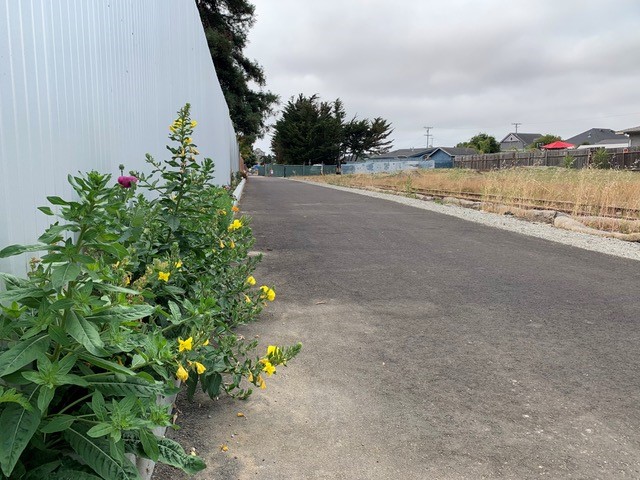
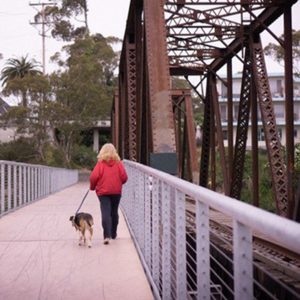 Clean, Quiet, Modern Rail Can Connect Community, Families
Clean, Quiet, Modern Rail Can Connect Community, Families
Amidst all the losses, inconveniences and parenting challenges inflicted by the pandemic, there have been some positive changes as well. Worldwide air pollution has reduced, more people are using bicycles, and as supplies in the stores are short, we’re learning how to be more efficient with what we have. We also have a window of opportunity now to create a Santa Cruz County that is safer and better connected for everyone who travels to school, work, and play here.
We have the opportunity to create a new system of car-free travel options for our community. The Rail Trail currently under construction is connecting neighborhoods between Watsonville and Davenport. Alongside the trail, we can have clean, quiet, modern rail service linking Watsonville with the City of Santa Cruz and to points beyond our county at Pajaro Station. At each rail stop, synchronized bus connections provide easy transfers to various county destinations. A network of safe streets with sidewalks and protected bike lanes provides safe passage for wheelchair users, skateboarders, cyclists and pedestrians of all ages. The combination of safe active transportation routes, rail service, and synchronized bus connections would provide our community with a modern, robust transportation system. This vision is called “Coast Connect.”
Many people are familiar with the Rail Trail. Half of Santa Cruz County’s population lives within one mile of the 32-mile route. Additionally, the Monterey Bay Scenic Sanctuary Trail Network Master Plan includes 18 miles of spur trails connecting the Rail Trail with other destinations. The total length of this trail network will be about 50 miles. The entire Rail Trail is expected to be complete by 2030. Imagine what this will mean to families! We’ll have a safe, car-free way to get to the 92 parks and 44 schools that are within a mile of the Rail Trail.
What about transit? Good public transit improves access to opportunity and freedom of movement for everyone in the community, including children, teens, and pedestrians of all ages. The Regional Transportation Commission (RTC) is committed to using our rail corridor for maximum community benefit. In addition to building the Rail Trail alongside the tracks, the RTC is studying what kind of public transit to run between Watsonville and Santa Cruz. So far, they’ve narrowed the choices to two bus and two rail options.
Because the bus options would require tearing up the tracks to build a road, they are very expensive and would be able to use less than half the existing corridor between Santa Cruz and Watsonville. Buses would run mostly on surface streets, making them less reliable.
The truly exciting prospect before us is the possibility of choosing a lightweight electric passenger rail system. Electric rail is quiet, reducing neighborhood impact. New battery technology makes overhead wires unnecessary. And thanks to Monterey Bay Community Power, electrified trams, trollies, or trains would use green power. Each stop could be served by synchronized bus service, making transfers easy.
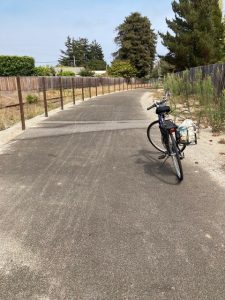 Can we afford this? Implementing rail costs less than half of what it would cost to upgrade the corridor for buses, and is much less expensive than building freeway lanes. CalTrans is shifting their funding from highways to railways. The State Rail Plan has budgeted $144 billion for passenger rail, including “Around-the-Bay” regional rail transit connecting Santa Cruz to Monterey, Gilroy, Salinas and beyond.
Can we afford this? Implementing rail costs less than half of what it would cost to upgrade the corridor for buses, and is much less expensive than building freeway lanes. CalTrans is shifting their funding from highways to railways. The State Rail Plan has budgeted $144 billion for passenger rail, including “Around-the-Bay” regional rail transit connecting Santa Cruz to Monterey, Gilroy, Salinas and beyond.
We must start planning for rail now, to provide for the future. Before the pandemic, congestion and carbon emissions in the county were growing at a devastating pace. Even now, traffic is on the rise again. The need for improved north-south transportation is critical. South County residents can spend 90 minutes in traffic (one way!) commuting to their jobs in North County. The RTC study revealed that passenger rail would cut that time in half. A trip between Watsonville and Santa Cruz would take only 41 minutes on rail, compared to 63 minutes on buses. Rail transit would give people that most precious commodity: Time. Time with family, time to prepare a nutritious meal, to help with homework, to engage in civic life, to enjoy the outdoors.
Let’s work together to transform transportation in Santa Cruz County! The choices we make now will impact families far into the future. To learn more about this exciting vision, visit CoastConnect.org. If you want to tell the RTC why you support rail transit on our rail corridor, please email the Transit Corridor Alternative Analysis team at [email protected]. Make your voice heard!
Sally Arnold is a retired Soquel School District teacher and board chair of Santa Cruz County Friends of the Rail & Trail.

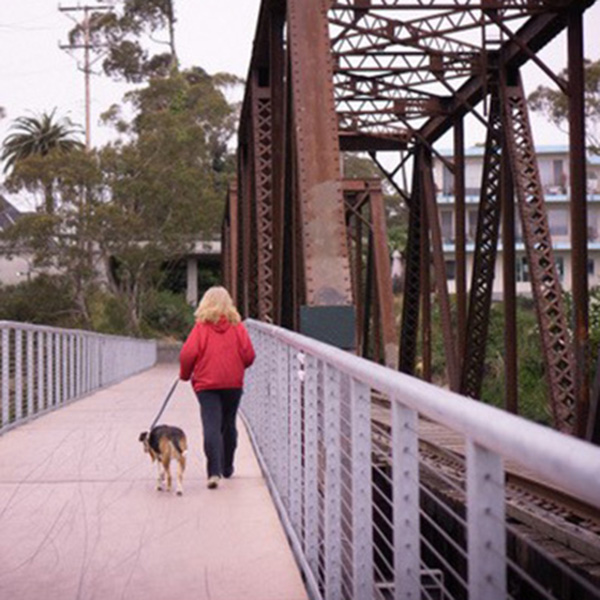





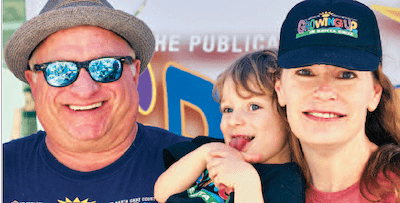

5 Comments
Barry Scott
Thank you, Sally, for a refreshingly positive and factual look at how a lightweight electric passenger rail system integrated with Metro service and commuting cyclists can meet everyones’ needs with equity and environmental goodness!
The same battery technologies that are used in electric vehicles and plug-in hybrid electric vehicles are being applied to rail transit vehicles today, providing an entirely new line up of rail service options. A new category of transit vehicles, “rapid streetcars” are easier to board than buses and use less power, and batteries eliminate the need for expensive and ugly overhead wires for power.
People who feel that buses are a better choice for the rail corridor should realize two important elements: First, a single cross county bus line won’t serve riders better than a fixed-rail route; either way a transfer is required for most trips. Second, bus service that’s integrated to work with the rail transit backbone may qualify for State Rail Plan funding, and an integrated bus+rail system could grow Metro ridership while bringing in a wider range of funding packages.
Let’s think of how a network of bikes and rail working in sync with Metro can deliver a more powerful punch than any one of them alone, or even the sum of those parts. With rail + trail + Metro, the whole is greater than the sum of the parts!
Faina Segal
I’m am so excited for the possibility of a really robust, clean and reliable transportation system in Santa Cruz County. As a WHS grad and former Cabrillo College and UCSC student, I believe the opportunities this system could bring to our students is worth any amount of investment, but especially so when there are so many state and federal funds set aside for rail projects like this. Systems like the Coast Connect vision that Sally has outlined keep our money in the community because they allow students, our grandparents and all who live and work here a way to get around town with-out gas or a car payment, and means more money for books, activities, food, and living expenses.
carey pico
This is a Pollyanna view of a railroad in Santa Cruz. (And I want a pink pony too!) There is one problem that Congressman Sam Farr pointed out to me: there is no money. The RTC’s own study estimates the cost to be $1.12B (billion with a B) to build and run the proposed commuter train. There’s a reason for lack of funds: Wikipedia list 40 cities with light rail. All of them are directly in or connected to a population of 1 million. Santa Cruz… has 274,000 today. Do you see Santa Cruz at 1 million to afford a train? I wouldn’t want to live here.
The author writes the train will go to Pajaro. Bad news. There is no commuter rail connection there and there won’t be. The last discussion in February 2020 by the Capitol Corridor board stated “We are not currently planning for a Capitol Corridor train extension to Salinas”, which means no Pajaro connection because… there is no money.
Another misstatement, “bus options would require tearing up the tracks to build a road, they are very expensive”. Any potential passenger rail also requires tearing up the tracks for something that can handle the RTC’s proposed 45-60 mph trains through the county. That’s more expensive. Don’t ask me, go look at the RTC’s Unified Corridor Investment Study, Appendix B and compare prices. Train is more.
But the real problem with the train is it is located in residential areas next to the ocean and far from commercial areas that need its proximity. This is a recipe for failure according to transportation studies.
As to the trail, the RTC told the public that 8 of the 32 planned trail miles were to be completed by 2018. Do you know how many were completed by then? Zero. Today a 200 ft long bridge extension over the San Lorenzo river is all that was done. What about the rest? No money, wrong plans, and problems. The first portion to be worked on, 2 miles on the West Side, turned out to be more difficult because the planners forgot to include excavation into account hillsides (what? this is Santa Cruz County). They reduced the trail to 1.2 miles of flat land. Whoops, construction bids came in 3 times the amount budgeted. Move money around and its under construction at $8M per mile… twice the cost of a rural freeway lane. Today – 10 years after the chance to start building a real rail-trail – just a bridge exists.
Back to the trail, a simple trail could be built with 5 years at 1/4th the cost if the RTC and Friends of the Rail AND Trail would stop pushing to keep the train tracks in place. The concept is railbanking where the federal government takes stewardship of the rail easement and the county builds a trail. The RTC is ideologically wedded to a train, so the picture is twist. They state it would take 10 years to rail bank. The federal Surface Transportation Board (train regulators) staff attorney told me personally it takes 8 months. He stated the biggest problem is that, once a municipality railbanks a stretch of rail easement, they don’t have the money to build a trail. WE HAVE THE MONEY! $85M. But it’s being squandered as I write this. $10M for the 1.2 miles on the west side (of course, Santa Cruz gets theirs before the money runs out). And that is flat land with no hillsides. What happens when you hit south of the SL river?
So, the author can write how wonderful life will be with a railroad with connector buses and a trail next to the tracks. Wont happen. And time will tick on and money will drain away (already $11M has been spent just on the tracks with another $40M in the actual RTC budget in the next two years) until we all get too tired to remember what we wanted in the first place… a simple trail that we can walk, stroller, bike, or sit along to enjoy (without a 45-60 mph hour train whizzing by).
David
“There is one problem that Congressman Sam Farr pointed out to me: there is no money.”–Carey Pico
Well then, by that logic, there is no money for the trail, either. May as well not do anything at all.
It will cost money to remove the tracks and build the trail–and you’ll have a corridor of less capacity and less value, not to mention the land ownership problems as easement issues kick in.
For those who are not familiar with what easements are, they are a type of property lease, allowing one person or entity to cross the property of another person or entity. They are pretty common for things like pipelines, power lines, and railroads.
They are also usually pretty specific. If the use for the easement is removed, the property reverts to the owner.
In this case, the easement agreements are for a railroad. The agreements do not say they are for a corridor, or a trail. Take up the tracks, the property goes back to the owners or designated parties in the original agreement. The right of way, the right for the railroad or the trail, legally goes up in smoke.
In short, no railroad, no easement, no trail.
Be careful what you wish for.
These things can get expensive.
https://www.seattletimes.com/seattle-news/was-public-railroaded-in-trail-deal/
Jack Brown
Sally Arnold – Board Chair of “Friends of the Rail & Trail”, receives praising comment by Barry Scott, member of FORT and paid political lobbyist. Self-serving back pattingThe cost of the current construction of Rail with a Trail is over $5,700 per linear foot. Multiply that out over 32 miles and you have a serious bill on your hands. You can’t get all that money from grants and in the new normal, people are not going to want to be crammed into tight spaces for long periods of time.
These people simply DO.NOT.CARE.ABOUT.A.TRAIL! Rail is their prerogative and literally will pursue it at all cost. With the type of “streetcar” these people are now advocating, only a few hundred people of the over 50,000 that clog Highway 1 will benefit from what will cost our county over $1,000,000,000 to implement and take decades to get there. They claim $144B is available but it simply isn’t true. Suburban rail is a failure and even rail that should be successful like Metrolink and Caltrain are seeing dire financial situations.
With the pandemic, wildfire losses and upcoming winter storms wreaking havoc on our road infrastructure, we need to stop the wasteful spending on special interest / developer projects and get real about Bus on Shoulder and fixing the systems we already have and saving the abandoned rail corridor for active transportation. Since the rail groups insist on trying to silence anyone that opposes them, it’s time to remove the incumbents on the County Board of Supervisors and RTC.
Be sure to vote for change this November.